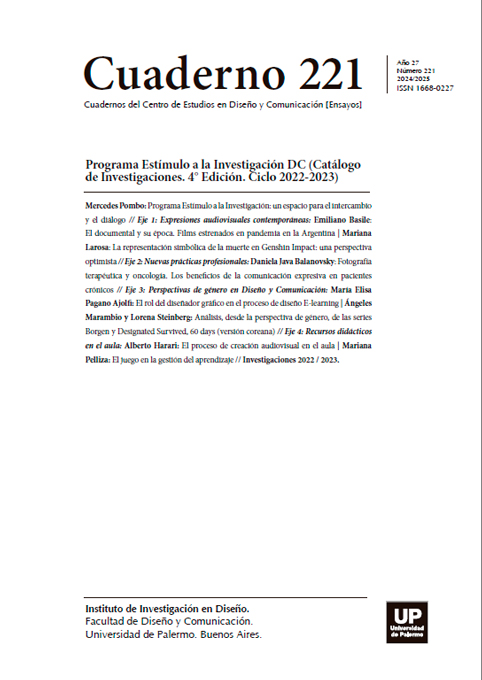La representación simbólica de la muerte en Genshin Impact: una perspectiva optimista
Resumen
Este proyecto analiza la representación de la muerte en el videojuego de orígen chino Genshin Impact.
Citas
Adams, S. (2014). Colorpedia. Diccionario del color para diseñadores. Barcelona: Promopress.
Barthes, R. (1970). Retórica de la imagen. Buenos Aires: Tiempo Contemporáneo Belting,
H. (2012). Antropología de la imagen. City Bell: Katz editores.
Díez, P. (2015). ¿Por qué el cuatro es el número de la mala suerte en China?. ABC Internacional. Disponible en https://www.abc.es/internacional/20150403/abci-china-cuatro-malasuerte-201504011204.html?ref=https%3A%2F%2Fwww.google.com%2F
Diffrient, D. (2018). Hong Kong Horror Cinema. Edinburgh: Edinburgh University Press.
Falero, A. (2007). Aproximación al shintoísmo. Salamanca: Amarú.
Farca, G. (2011). Narratives in Video Games. ResearchGate. Disponible en https://www.researchgate.net/publication/309232813_Narratives_in_Video_Games
Gómez Martín, D. (2015). Iconografía de la muerte en el arte moderno occidental. San Cristóbal de La Laguna: Universidad de La Laguna.
Hernández-Araico, S. (1987). Mitos, simbolismo y estructura en Apolo y Climene y el hijo del sol, Faetón. Liverpool: Bulletin of Hispanic Studies.
HoYoLAB (2023). HoYoWiki. Disponible en https://wiki.hoyolab.com/pc/genshin/home
Ladner, M. (2022). Significado del color morado en la cultura china. Filosofia.co. Disponible en https://filosofia.co/definiciones/significado-del-color-morado-en-la-cultura-china/
Lester, P. (2013). Syntactic Theory of Visual Communication. Indiana: Indiana University Press.
Luchko, E. (2021). Representation of the ancient myth about Hyperion in modern graphic literature. Czestochowa: Scientific Journal of Polonia University.
Martínez, C. (2017). Una mariposa nocturna que ha inspirado a célebres artistas. Museo Nacional de Ciencias Naturales (España) Disponible en https://www.mncn.csic.es/es/comunicacion/blog/una-mariposa-nocturna-que-ha-inspirado-celebresartistas#:~:text=El%20g%C3%A9nero%20Acherontia%20debe%20su,los%20muertos%20en%20su%20barca.
Mitchell, W. (2009). Teoría de la imagen. Madrid: Akal.
Panofsky, E. (1998). Estudios sobre iconología. Madrid: Alianza Editorial.
Pastoriza, M. (2022). ¿Cuántos jugadores tiene Genshin Impact? Recuento total (agosto 2022). Disponible en https://www.dexerto.es/genshin-impact/cuantos-jugadores-tiene-genshinimpact-recuento-t otal-octubre-de-2021-1450416/
Pérez Rufí, J. y Pérez Rufí, M. I. (2018). Estereotipos del cine de zombis y televisión: The Walking Dead. Razón y palabra, 22 (103), p. 122-139.
Pilipovic, S. (2023). How many people play Genshin Impact? — 2023 statistics Disponible en https://levvvel.com/genshin-impact-statistics/
Prósperi, G. (2021). Logos y Hades. La Plata: Anales del Seminario de Metafísica.
Samuels, A. (2017). Symbolism In Videogames: Finding The Balance Between Dark And Light. The Ontological Geek. Disponible en http://ontologicalgeek.com/symbolism-in-videogames-finding-the-balance-between-dark-an d-light/
Santander Oliván, M. (2009). Occidente y la caída de la dinastía Qing: del Imperio a la República de China. Disponible en https://dialnet.unirioja.es/servlet/articulo?codigo=3264032
Statista (2023). Global Genshin Impact app downloads 2020-2022. Disponible en https://www.statista.com/statistics/1251724/genshin-impact-number-of-downloads-worldwid e/
TGG (2022). What is the Average Player Age in Genshin Impact? Disponible en https://theglobalgaming.com/gaming/genshin-impact-average-player-age
Thompson, D. (2012). Designing serious video games for health behavior change: current status and future directions. Disponible en https://www.researchgate.net/publication/38066136_Journal_of_Diabetes_Science_and_Technology_and_the_Diabetes_Technology_Community
Udonis (2023) The Secret Behind Genshin Impact Advertising Strategy. Disponible en https://www.blog.udonis.co/mobile-marketing/mobile-games/genshin-impact-advertising#:~:text=Genshin%20Impact%20Demographics&text=The%20gender%20distribution%20is%20quite,the%20average%20age%20is%2035
Los autores/as que publiquen en esta revista ceden los derechos de autor y de publicación a "Cuadernos del Centro de Estudios de Diseño y Comunicación", Aceptando el registro de su trabajo bajo una licencia de atribución de Creative Commons, que permite a terceros utilizar lo publicado siempre que de el crédito pertinente a los autores y a esta revista.


